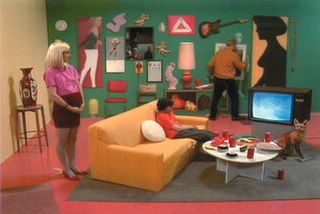Caught old avant-gardeners (to steal a phrase from
Josh Corey’s committee chair)
Michael Snow and
Tony Conrad at the Getty Tuesday night. Snow showed a “remixed” version of his classic
Wavelength that managed to betray the promise of its title,
WVLNT—Wavelength for Those Who Don't Have the Time. I suppose it’s a pun, since this version was shortened from 45 to 15 minutes, and if
Wavelength is about anything it’s about the concept of time and duration (for those not in-the-know
Wavelength is one seemingly continuous 45 minute zoom through a room – though it’s actually several different takes –that ends on a photograph of ocean waves, accompanied by a sine-wave electronic soundtrack); but someone watching
WVLNT without having seen
Wavelength will not get a condensed or Cliffs Noted version; rather she’ll see an entirely different film, as
WVLNT super-imposes three sections of the film and soundtrack, running them simultaneously. In this case I’d suggest sticking with the classics. Snow also disappointed by implying he’s against remix culture and artistic appropriation. When explaining why he made this new version of
Wavelength, and why there's no DVD copy of the original available, he replied that
Wavelength should only be seen in its original medium (which I agree with) and that these days young people can remix anything once it’s in a digital format. He figured he’d remix it himself before another artist got his hands on it. I guess he wants to avoid
the fate of John Baldessari.

from
Living Room by Michael Snow
Snow also screened See You Later/Au Revoir, and
The Living Room, the latter notable for using digital effects now common in many Hollywood films. Here I think Snow has achieved something; he’s made a decidedly non-kitsch film entirely out of kitsch components. Living Room reminded me somewhat of that famous Richard Hamilton collage with a muscle-man in a living room, but in an interview Snow says it’s just coincidental. Regarding See You Later/Au Revoir (in which a 30 second shot of a businessman getting up from his desk, passing by his secretary, and leaving the office is slo-moed to last 18 minutes), I was quite surprised to learn of the non-theoretical intent of the piece – I figured a hardcore structuralist like Snow would have a complex theory behind his work. In conversation he basically said that he just thought it would be interesting to slow things down. I’ll leave Franklin to describe the Tony Conrad films; aside from the footage of a young Mike Kelley yelling like Jerry Lewis in the army, and the hypnotic criss-crossings of Straight and Narrow, his films did nothing for me. Conrad did have a few good quotes, though. I wish I had copied them down, but paraphrasing: film is the space between nothing happening and something happening (suitable for a structuralist, I’d say); and later, describing how most artists he knew in New York City during the 1960s didn’t have jobs, or were ideologically against the idea of having jobs: we managed to survive by floating along on society’s economic froth.

1 comment:
I went bowling once after seeing Tony Conrad at a Black Mountian College festival. Some how I ended up bowling with Mel Chin, Tony Conrad and Andrew E. Johnson. We ended up at a bar in Buffalo where Ani Difranco was celebrating her birthday. It was one fluxed up night.
Post a Comment